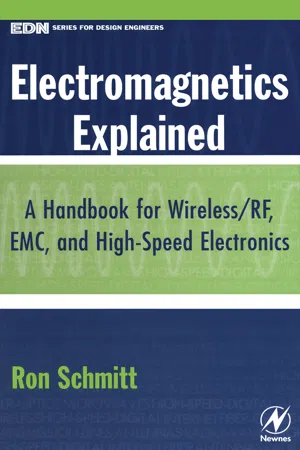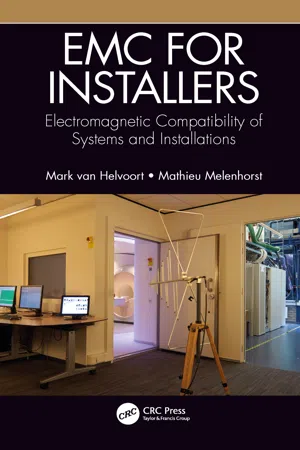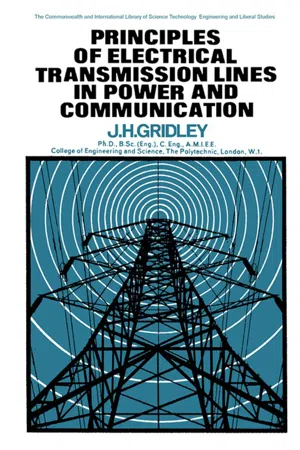Characteristic Impedance of a Cable
The characteristic impedance of a cable is a measure of its opposition to the flow of alternating current. It is determined by the cable's physical dimensions and materials. It is an important parameter in the design and operation of electrical transmission lines, as it affects signal integrity and power transfer efficiency.
3 Key excerpts on "Characteristic Impedance of a Cable"
- eBook - ePub
Electromagnetics Explained
A Handbook for Wireless/ RF, EMC, and High-Speed Electronics
- Ron Schmitt(Author)
- 2002(Publication Date)
- Newnes(Publisher)
...Along the entire length of the line, the ratio of the voltage to the current is constant. This ratio is the characteristic impedance, Z o, and is defined by the geometry of the line and the permittivity and permeability of the dielectric. The characteristic impedance equations are often complex. For example, for a coaxial cable transmission line, where d is the diameter of the inner conductor, D is the inside diameter of the outer conductor, and ε r is the relative dielectric constant of the material. Figure 8.4 This figure shows two snapshots in time of a signal pulse traveling along a transmission line. Both the voltage and current waves are shown. RELATIONSHIP BETWEEN THE MODELS Now you have two models for a transmission line: a circuit comprising infinitesimal inductances and capacitances with parameters L and C, and a waveguide for signals with parameters v and Z o. The following equations relate the parameters of the two lossless models: and Although these models are interchangeable, the waveguide model is usually more useful for transmission line analysis. For the remainder of the chapter, I will focus on the waveguide model. REFLECTIONS Whenever an electromagnetic wave encounters a change in impedance, some of the signal is transmitted and some of the signal is reflected (Figure 8.5). The interface between two regions of different impedances is an impedance boundary. An analogy helps in understanding this concept. Imagine yourself sitting in a small boat on a pond, looking down into the water. A fish swimming by sees you from below the water’s surface because water is transparent. In addition, you faintly see your image as a reflection on the water’s surface. Hence, some of the light from your image travels through the water to the fish, and some of the light reflects back to you...
- eBook - ePub
EMC for Installers
Electromagnetic Compatibility of Systems and Installations
- Mark Van Helvoort, Mathieu Melenhorst(Authors)
- 2018(Publication Date)
- CRC Press(Publisher)
...As can be observed, the measured current (or voltage) in the transmission line does not only depend on the time, but also on the location at the wire. Both voltage and current move as a wave through the transmission line. This phenomenon is known since the introduction of the telegraph and has been analytically described with a pair of differential equations known as the telegrapher’s equations (Heaviside 1892). The telegrapher’s equations can be modeled as an electrical circuit consisting of a ladder network with identical components in every section, such that every segment ∆ x is shorter than λ /10 (see Figure 3.26). FIGURE 3.25 Current as measured on point x along an electrically long wire above a ground plane at three different moments in time. The components R ′, L ′, G ′, and C ′ are the distributed resistance, inductance, conductance, and capacitance, respectively, each representing an infinitesimal small length and are expressed per unit length. The equivalent diagram of the transmission line shows that the ratio of the voltage over each section and the current through each section equals Z 0 = R + j ω L G + j ω C (3.10) where Z 0 is called the characteristic impedance. In the lossless case, Z 0 reduces to Z 0 = L C (3.11) In measurement systems often 50 Ω coaxial cables are used, this means that these cables have a characteristic impedance Z 0 = 50 Ω. FIGURE 3.26 Equivalent diagram of (a) a lossy transmission line and (b) a lossless transmission line. 3.4.3.2 Reflection, transmission, and cable resonance The solutions of the telegrapher’s equations show that the voltage and current waves can be reflected at the end of the cable...
- eBook - ePub
Principles of Electrical Transmission Lines in Power and Communication
The Commonwealth and International Library: Applied Electricity and Electronics Division
- J. H. Gridley, P. Hammond(Authors)
- 2014(Publication Date)
- Pergamon(Publisher)
...The shunt conductance may be neglected. Calculate the characteristic impedance of the line at 5000 c/s. If the load impedance at the receiving end has this value, and a voltage of 200 V, 5000 c/s is applied at the sending end, calculate (a) the magnitude of the received current, (b) the wavelength, and (c) the velocity of propagation. (I.E.E., Pt. III, Dec. 1960.) 5.2. Derive from first principles an expression for the input impedance of a loss-free transmission line in air when the far end of the line is short circuited. Calculate the minimum length of a line to provide an inductive reactance which is numerically equal to the characteristic impedance, assuming the frequency to be 100 Mc/s (L. U., B. Sc. (Eng.), Pt. III, 1959.) 5.3. A uniform telephone line has the following primary constants per unit length: resistance R ohms; inductance L henrys; conductance 6 mhos; and capacitance C farads. Derive from first principles an expression for the characteristic impedance of the line. A telephone line has the following constants per loop mile: R = 40 Ω; L = 50 mH, G = 10 μmhos and C = 0·06 μF. Determine the frequency at which the magnitude of the characteristic impedance is 950 Ω. (L. U., B. Sc. (Eng.), Pt. III, 1960.) 5.4. A long transmission line has a characteristic impedance Z 0 and is terminated with an impedance Z L. Derive, from the voltage and current equations of such a line, an expression for the input impedance in terms of Z L, Z 0 and Z 0 C, where Z 0 C is the input impedance when Z L is removed. At a certain frequency, Z 0 = 75 /0 ° _ Ω, Z L = 100 / 45 ° _ Ω and Z 0 c = 100 /-45 ° Ω. If, at this frequency, the voltage applied to the line is 100 V (r.m.s.), calculate the power input to the line. (I.E.E., Pt...


